We have a strict honest review policy, but please note that when you buy through our links, we may receive a commission. This is at no extra cost to you.
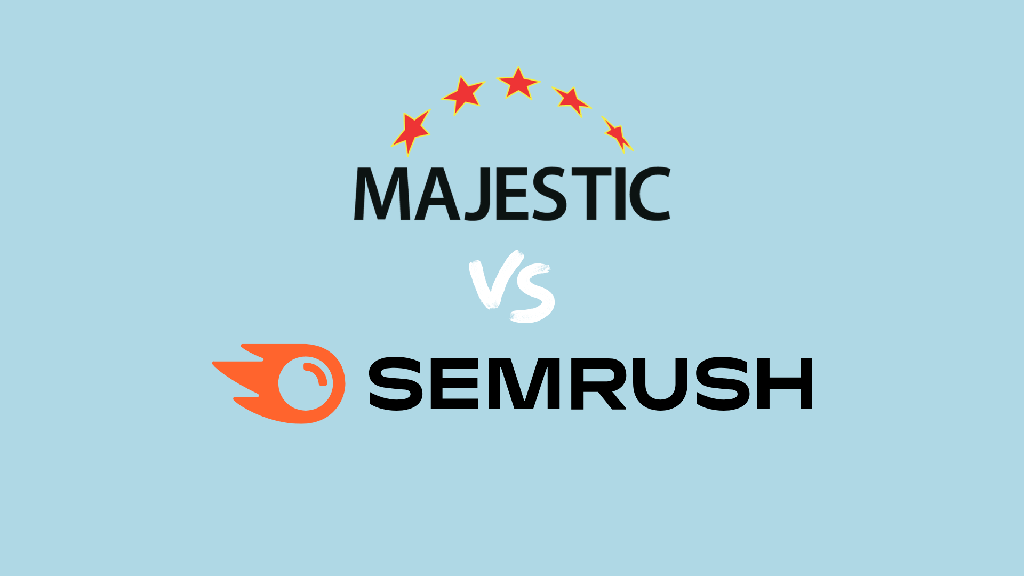
Majestic vs Semrush: Which SEO tool should you choose? In this post, I’ll break down the key strengths of both platforms and highlight where each one outperforms the other — helping you decide which tool is the better fit for your needs.
Majestic and Semrush: a quick overview
Majestic is a long-established SEO tool with a very specific focus: backlinks. Unlike all-in-one platforms that try to cover every aspect of digital marketing, Majestic is almost exclusively concerned with link data.

It gives you detailed insights into how websites are connected, how influential those connections are and how link profiles change over time — making it a favorite among SEOs who specialize in link building, outreach and domain research.
Semrush takes a much broader approach. It’s a comprehensive platform that gives you features for dealing with SEO, content marketing, PPC, social media and competitive analysis — over 55 different tools in total are provided. While it also includes comprehensive backlink analysis features, its strength lies in giving you a complete picture of online visibility, making it a go-to option for users who want to access as much marketing data as possible in one place.

From my own experience of using both tools, I’ve found that each one has its own strengths and weaknesses.
I’m going to spell these out now — first by highlighting the areas where Majestic beats Semrush, and then by taking a look at the advantages Semrush has over Majestic.
Reasons to use Majestic over Semrush
1. Majestic gives you more historical data
Majestic’s backlink data is organized into two core indexes — a ‘Fresh Index’ that covers the last 120 days and a ‘Historic Index’ that dates all the way back to 2006. Between them, they contain over 21 trillion discovered URLs and 4.5 trillion crawled pages. This makes the tool particularly well-suited to analyzing older websites, reviewing legacy SEO campaigns, or carrying out forensic link audits.
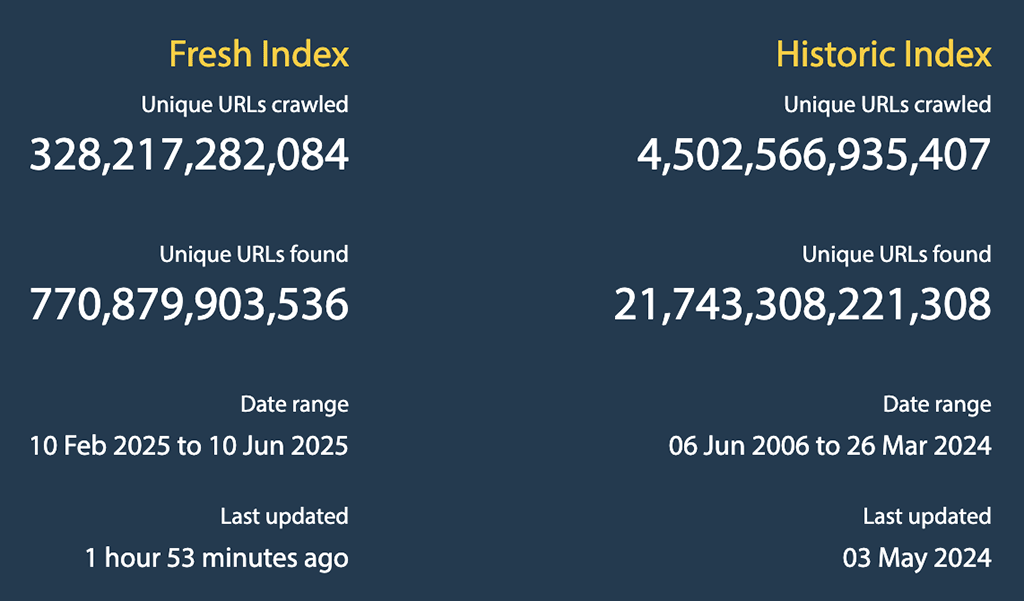
Semrush has a larger overall backlink database — containing over 43 trillion links — but its historical data only goes back to 2012. It doesn’t separate this into a standalone historic index like Majestic does; and older links are folded into general reports, with fewer tools available for in-depth historical analysis.
It’s also more affordable to access historical data in Majestic — its historic index is included on its $99 per month ‘Pro’ plan. With Semrush, you’ll need to be on an expensive $249.95 per month ‘Guru’ plan or higher to access historical backlink data.
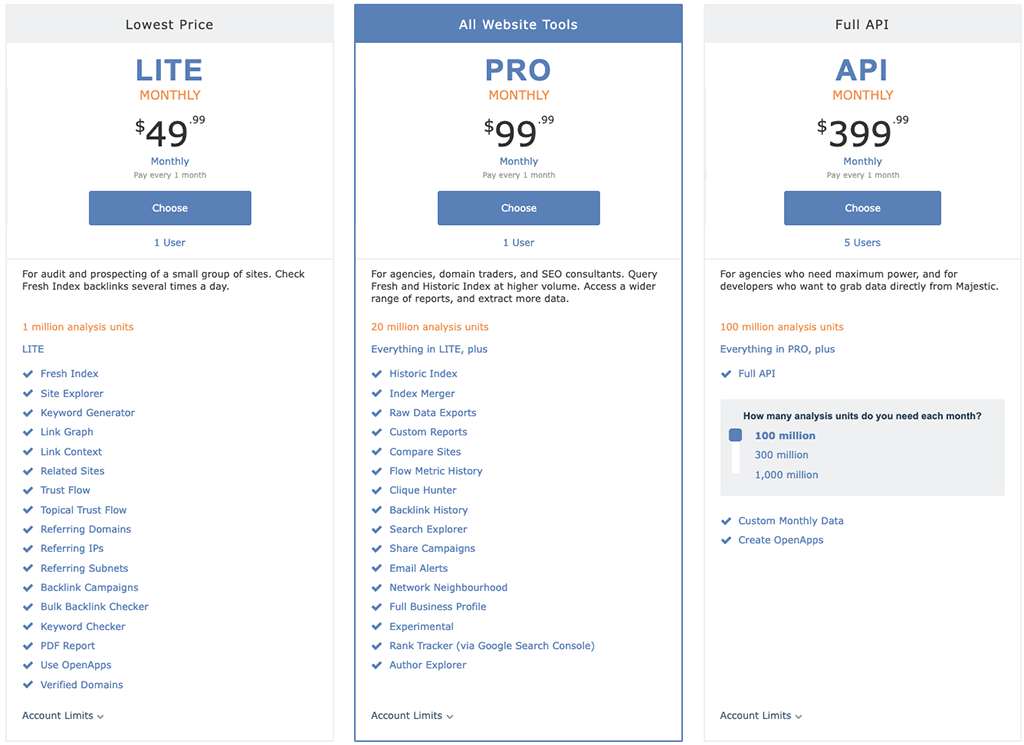
So while Semrush may provide a broader and more up-to-date snapshot of the web, Majestic arguably offers more depth when it comes to long-term link tracking.
2. Majestic gives you more granular insights into domain authority
Majestic SEO uses two proprietary metrics — ‘Trust Flow’ and ‘Citation Flow’ — to help users evaluate domain quality.
‘Trust Flow’ scores a site based on how closely its backlinks connect to a curated set of trusted seed websites, while ‘Citation Flow’ measures the overall volume of external links pointing to it.
They effectively let you look at domains from two perspectives — trustworthiness and ‘link juice.’
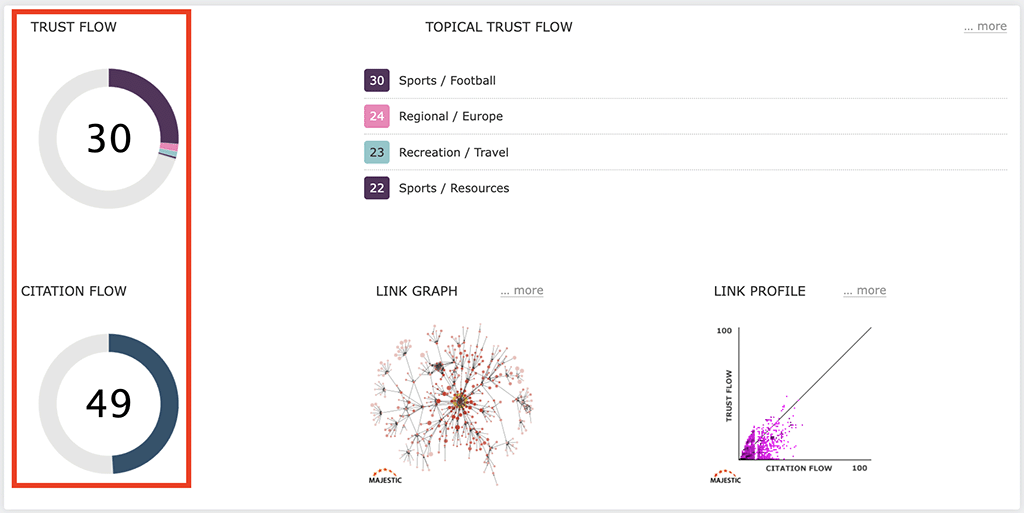
Semrush, by contrast, gives you just one metric for assessing domain strength — its authority score. While this does factor in spam factors and link power (quality and quantity of backlinks), it doesn’t offer a split view of these.
So for those looking for more granular detail on domain strength, Majestic may be a better choice. This perhaps explains why the Majestic domain metrics are widely used used in specialist workflows — particularly by link builders, domain brokers and affiliate marketers — where quick backlink assessment is key. You’ll often see them applied in tasks like evaluating expired domains, screening outreach prospects or analyzing competitor link strategies.
3. Majestic shows you where backlinks appear on the page
Majestic’s ‘Context Report’ report gives users a breakdown of exactly where a backlink appears within the referring page — whether it’s embedded in the main body content, tucked into a footer, listed in a sidebar or grouped with other outbound links. It also provides surrounding text and identifies nearby links, helping you judge how prominent or editorially valuable a link really is.
This is an interesting approach, and not one that I’ve encountered in competing tools I’ve tested.
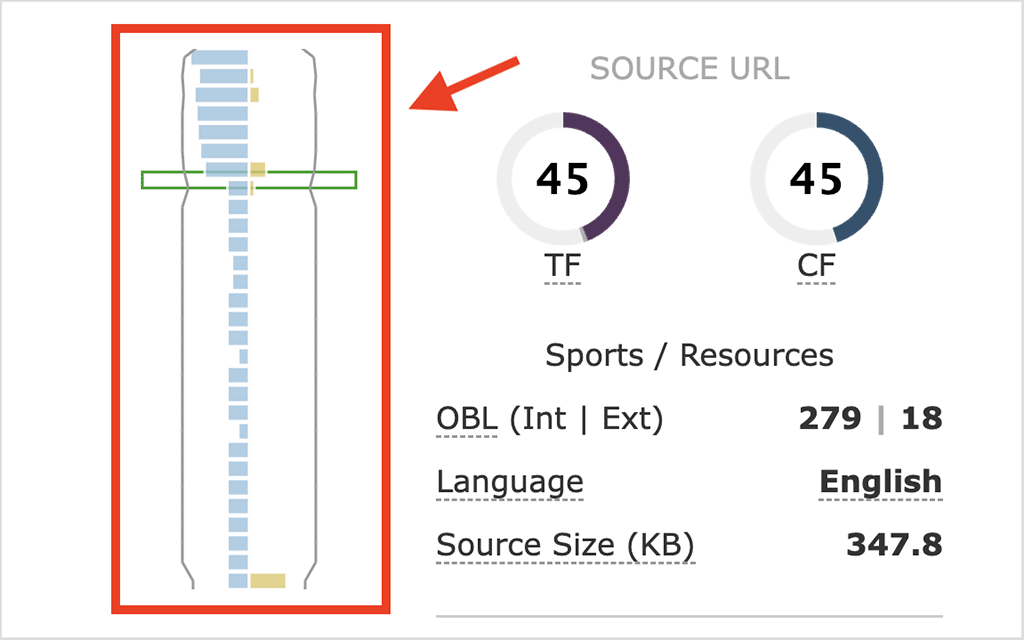
This kind of detail is particularly useful in link building and backlink auditing, where not all links carry equal weight. A link placed within relevant body copy is generally considered more trustworthy and impactful for SEO than one buried in a template or navigational section; and Majestic’s reporting makes it easier to identify these stronger links and spot patterns in a site’s backlink profile.
Semrush, by comparison, shows linking domains, anchor text and key link attributes, but doesn’t provide placement-level detail or visual context. So for SEOs who care not just about who is linking, but how and where links are positioned, Majestic provides a layer of insight that you won’t get from Semrush.
4. Majestic offers better tools for competitive backlink analysis
Majestic offers a set of backlink tools tailored specifically to competitive link research. Its ‘Clique Hunter’ lets you compare up to 10 domains at once and highlights websites that link to your competitors but not to you. This is double the limit offered by Semrush’s equivalent ‘backlink gap’ feature.
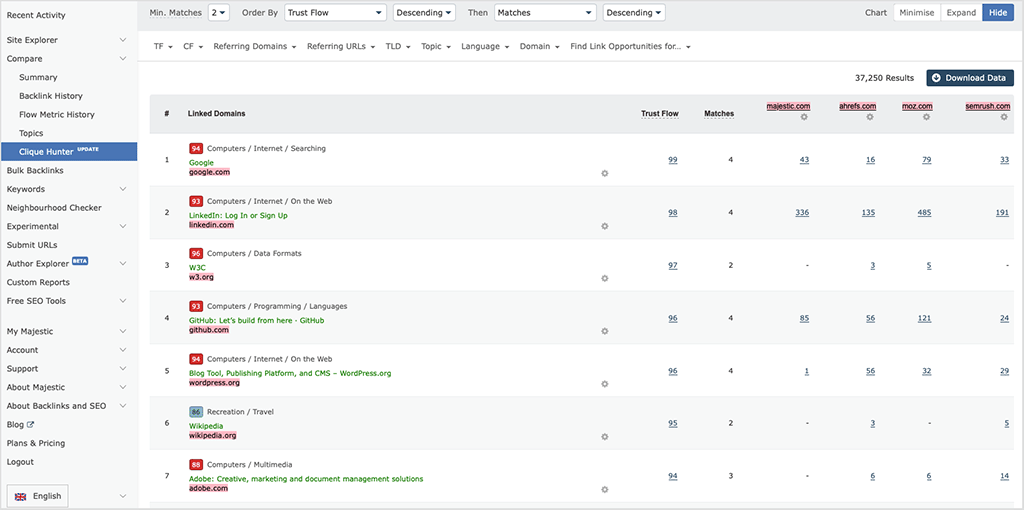
Another standout backlink analysis feature in Majestic is its ‘Topical Trust Flow’ rating, which categorizes referring domains by subject matter. This helps you assess not just link authority, but also thematic relevance — a useful bit of information when evaluating potential link sources or mapping competitor strategies.
Semrush’s equivalent backlink gap tool is also useful for spotting overlaps and missing links across up to five domains; and includes filters such as authority score, link type and follow status. However, it doesn’t provide topic-based classification or the same depth of comparative backlink mapping.
For users focused specifically on competitive link-building, I’d argue that Majestic’s toolkit offers a more specialized — and in some areas, more powerful — set of features.
5. Majestic provides more sophisticated backlink network mapping features
Both Semrush and Majestic offer tools that visualize backlink networks, but they serve slightly different needs.
Semrush’s backlink network graph shows connections up to three tiers deep — analyzing up to 12 first‑tier, 10 second‑tier and 8 third‑tier referring domains. This helps you spot site clusters, authority hubs and suspicious link networks. It’s clean, integrated with Semrush’s broader analytics and useful for gaining quick strategic insights.
Majestic’s ‘link graph,’ however, remains the more advanced tool for forensic link analysis.
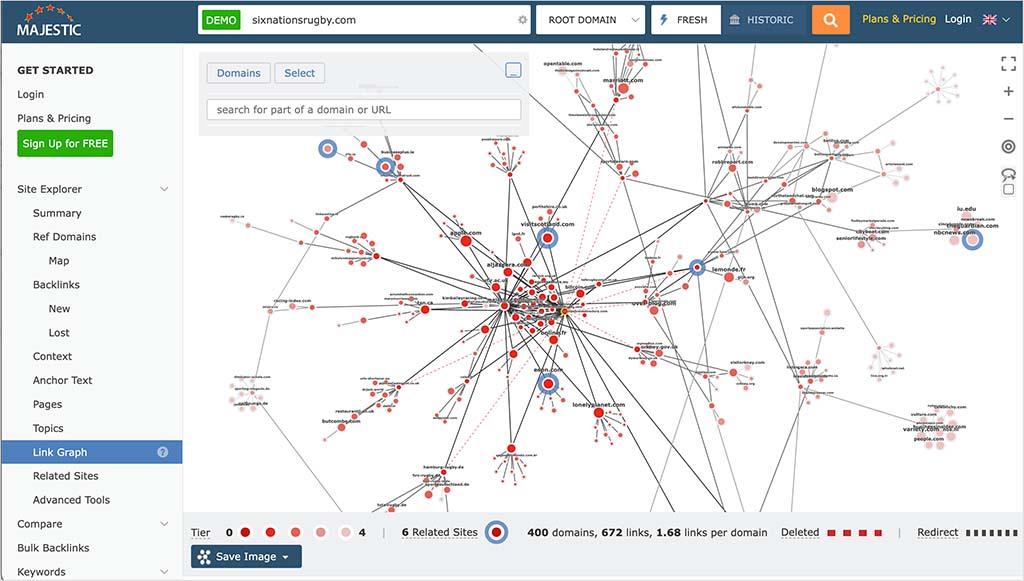
It visualizes backlink networks up to four tiers deep, highlights link hubs and integrates Majestic’s hallmark ‘Trust Flow’ and ‘Citation Flow’ metrics directly on the graph. This level of depth and control makes it a better choice than Semrush for conducting detailed link audits (for example, to uncover private blog networks or structural link schemes).
Overall, Semrush delivers a strong network visualization with useful context — but Majestic sets the bar for the provision of deep, structural backlink forensics.
6. Majestic suggests keywords based on backlink context
Although Majestic isn’t designed as a full keyword research tool, it does provide a keyword generator that surfaces keyword ideas drawn from anchor text and the content of linking pages. This backlink-centric approach can be useful for identifying recurring themes in a link profile — or for spotting topical gaps between your content and the kinds of terms that external sites are associating with your domain.
The feature is particularly helpful when you’re building a content strategy around existing link equity or trying to understand the language other sites use when referencing your competitors.
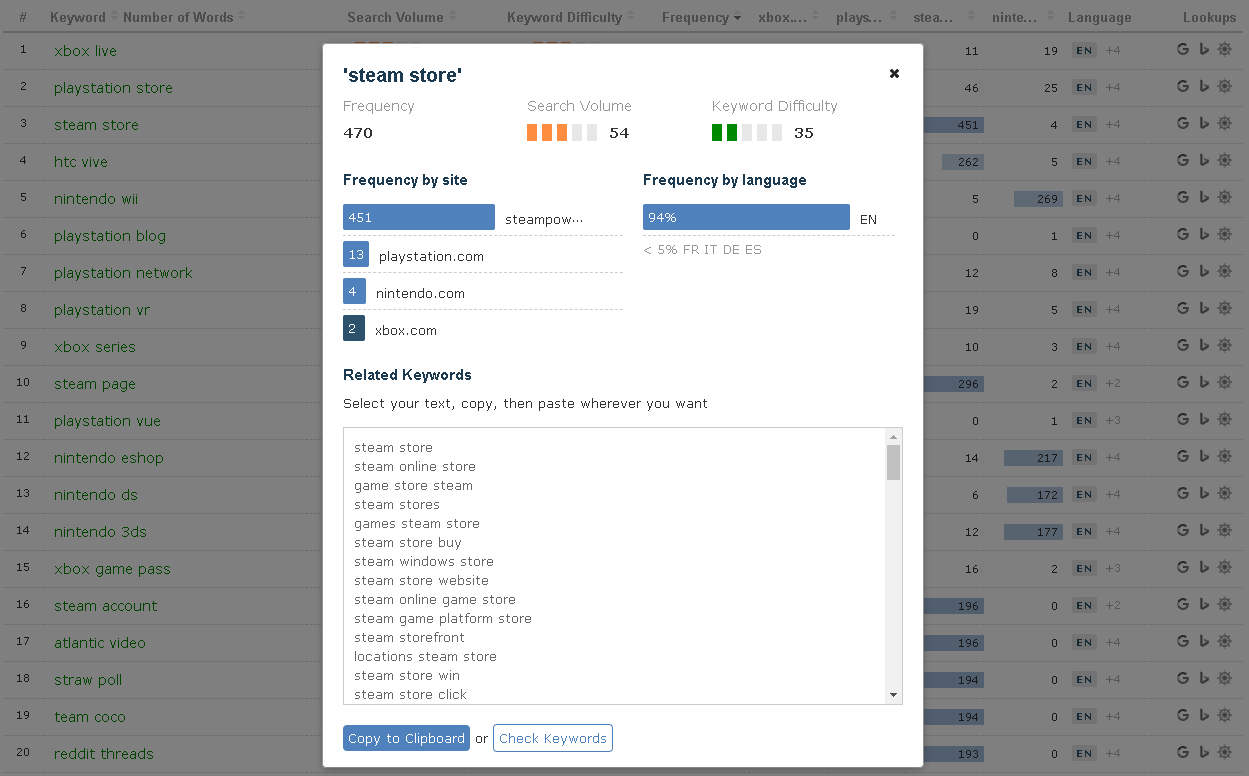
Semrush offers a far more extensive suite of keyword research tools, giving you traditional keyword suggestions, intent analysis, difficulty scores and traffic potential metrics — all of which go well beyond anything Majestic provides.
However, Semrush’s suggestions are powered by large-scale search engine databases rather than backlink context; so while Majestic’s approach is narrower in scope, it offers a distinctive perspective rooted in link profiles. This means that the tool can be valuable for backlink-informed content planning.
So those are my key reasons for using Majestic over Semrush — now I’m going to look at the reasons you might want to use Semrush instead.
Reasons to use Semrush over Majestic
1. Semrush is a complete marketing platform
While Majestic focuses almost entirely on the provision of backlink data, Semrush gives you a much more comprehensive feature set. It’s an ‘all-in-one’ platform that gives you tools for performing keyword research, rank tracking, site auditing, content marketing, competitive analysis and advertising research — making it suitable for creating an entire marketing strategy, and not just link building.
Take Semrush’s ‘Domain Overview’ tool, for example (pictured in my screenshot below). When you enter a URL into it, the tool instantly gives you key metrics like estimated traffic, top-performing keywords, branded vs non-branded traffic, search intent breakdowns and a visual map of where the domain sits relative to its competitors. These are all pieces of information that I couldn’t find anywhere in Majestic.
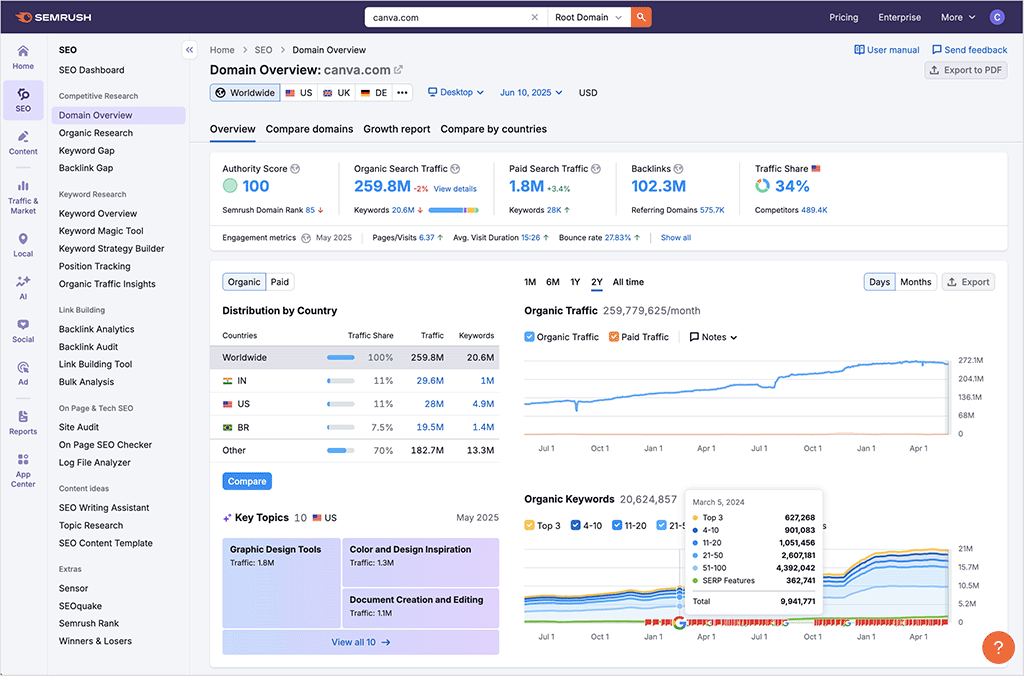
And if you’re working on content, Semrush helps you out with this via tools like its SEO writing assistant and content optimizer. These help you find topic gaps, improve your on-page optimization and create copy that aligns with user intent. You won’t find any of this sort of content marketing functionality in Majestic’s link-focused feature set.
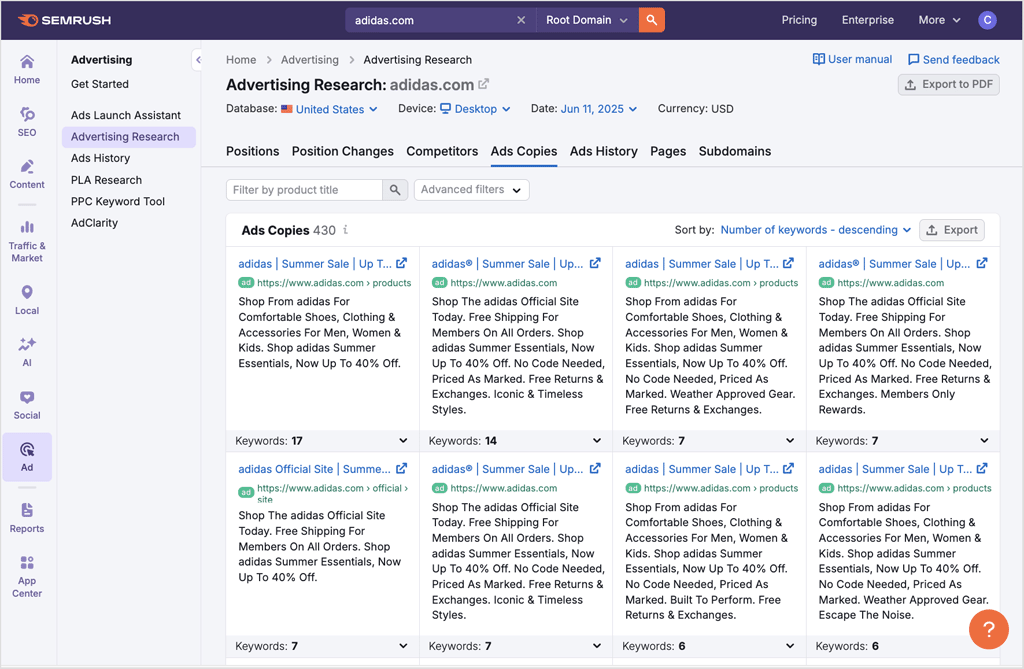
Additionally, if you run paid campaigns, you’ll get a lot of value out of Semrush’s PPC toolkit. This lets you spy on competitors’ ad strategies, uncover top-performing keywords and analyze traffic from paid search. Again, there isn’t anything comparable available from Majestic.
2. Semrush offers a cleaner, more modern user experience
Semrush’s interface strikes a strong balance between power and user-friendliness.
Despite packing in over 50 tools, it presents data in a way that’s easy to absorb. This is thanks to well-organized menus and clean visualizations that make even complex reports relatively easy to interpret. A recent design refresh has further improved usability, streamlining key workflows and giving the platform a more modern, professional feel. I’d go so far as to say that of the SEO tools I’ve tested, Semrush boasts the slickest UI.
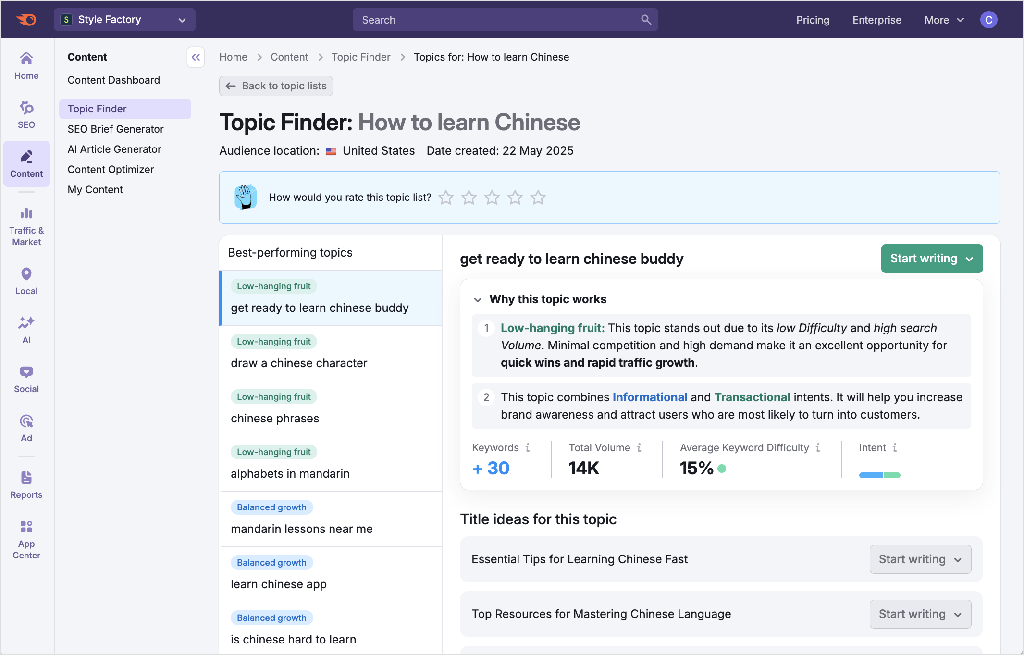
Majestic’s interface, by contrast, hasn’t seen the same level of refinement and visual and UX upgrades. While its underlying backlink data is strong, the platform feels cluttered and dated, thanks to the use of older design conventions.
So if you value a smooth, well-structured experience — especially when working with large volumes of data — you’ll probably prefer Semrush to Majestic.
3. Semrush gives you excellent site auditing tools
One of Semrush’s standout features is its advanced site audit tool. This performs over 150 checks for technical SEO problems — including broken links, crawl errors, duplicate content, missing meta tags, HTTPS misconfiguration and Core Web Vitals issues. Audit results are clearly categorized by issue type and severity, and helpful guidance on how to address each problem is provided.
Additionally, Semrush’s ‘site health score’ gives you an instant overview of your website’s technical condition, making it easy to benchmark progress over time.
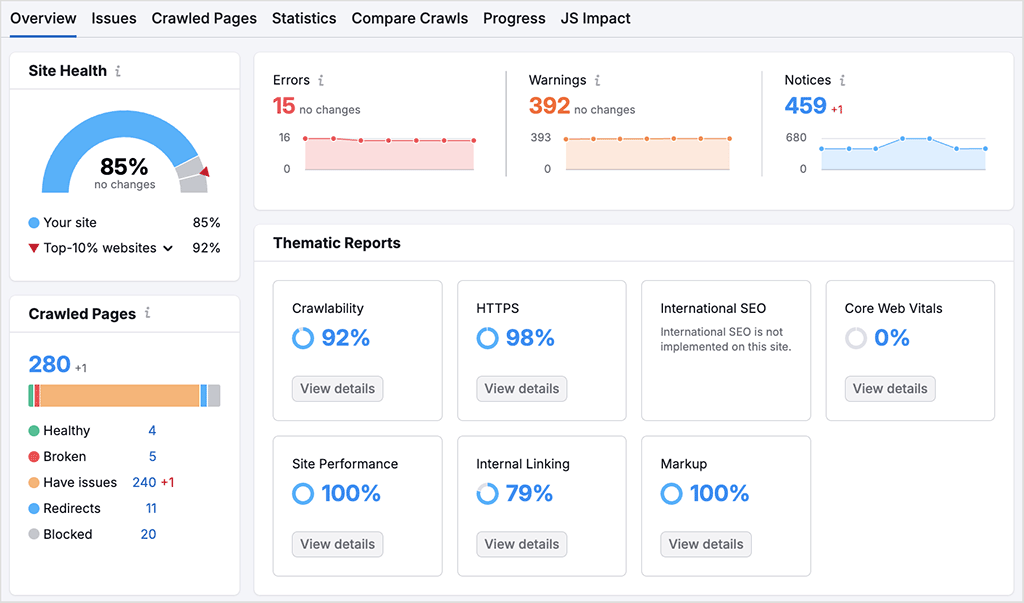
And for larger projects, Semrush’s auditing capacity is particularly impressive. Depending on your plan, you can crawl and audit 100,000 to 1 million pages per month. You can also push your audit findings directly into Trello (or integrate with Zapier to send tasks to other project management platforms) — this makes Semrush ideal for agencies or teams working collaboratively on SEO improvements.
By contrast, Majestic doesn’t offer any site auditing functionality at all. As mentioned repeatedly through my post so far, its focus is squarely on backlink data. So if you’re looking for an all-in-one solution that provides technical SEO checks alongside backlink analysis, the clear winner is Semrush.
4. Semrush is much better for keyword research
Although technically Majestic gives you keyword suggestions, these originate from anchor text and page titles commonly used in your niche — not necessarily the phrases people are actually searching for.

Semrush, by contrast, gives you full access to real search volumes. Its database contains over 26.7 keywords, along with information relating to keyword difficulty, competition, search intent and more. It also gives you personalized keyword difficulty scores, which tell you how hard it will be to rank for a particular phrase based on the overall authority of your website and the topics it already covers.
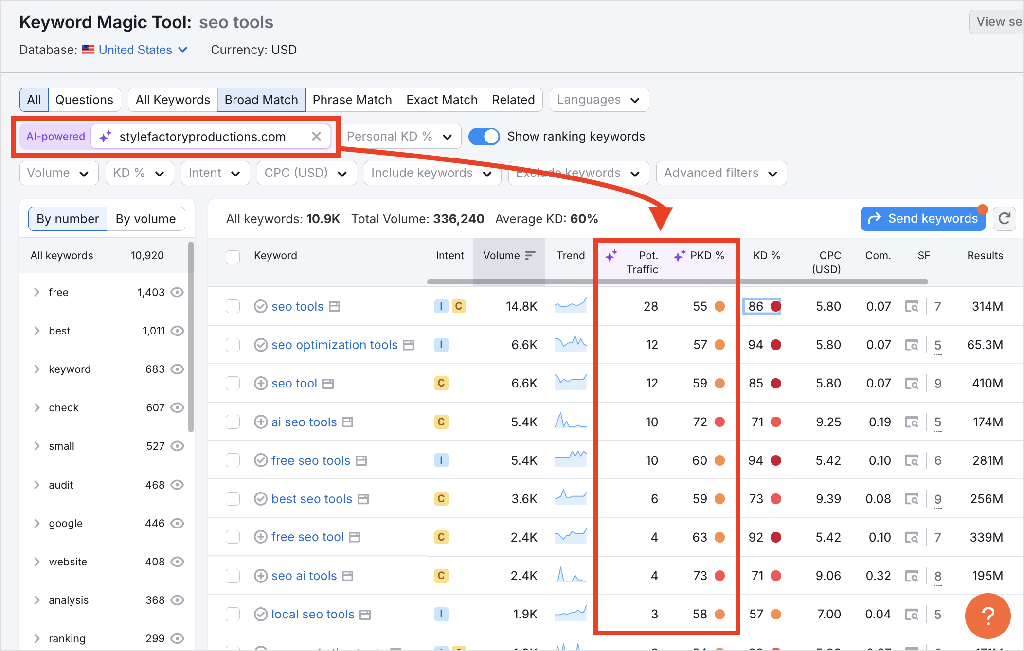
You won’t find any of this sort of thing in Majestic — and this makes Semrush a much better choice for keyword research.
5. Semrush provides advanced rank tracking capabilities
Semrush gives you one of the most powerful and flexible rank tracking tools on the market. Its ‘position tracking’ feature lets you monitor how your site is ranking for specific keywords — across desktop, mobile and local search results. And by default you can do this on a daily basis.
Setting up a rank tracking campaign in Semrush is very straightforward: you just enter your domain, input your target keywords and Semrush starts tracking your position in Google, Bing, Baidu and even ChatGPT Search. You can monitor rankings by country, device and zip code — which makes the tool particularly useful for local SEO campaigns or multi-region websites.
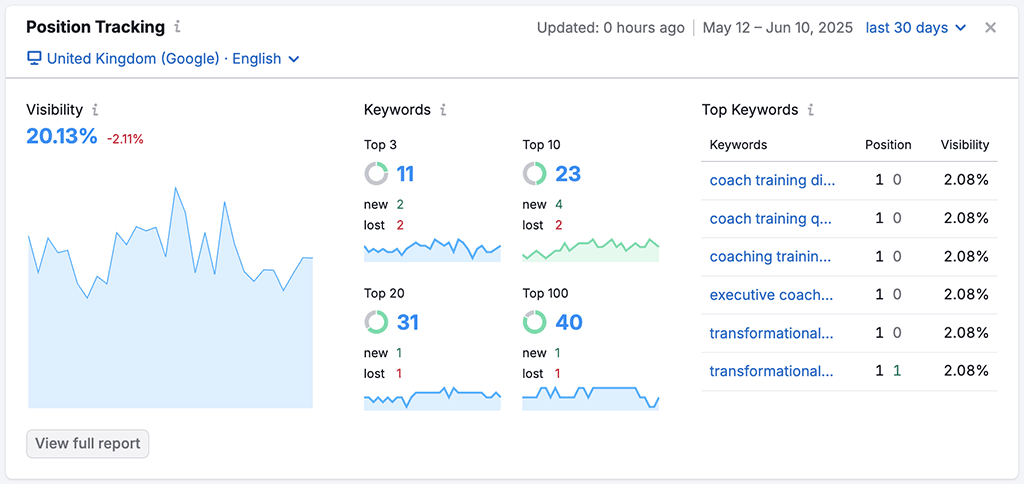
There are several standout features provided by Semrush that go beyond the basics. You can tag and group keywords by intent; benchmark your performance against direct competitors; and visualize share-of-voice metrics over time. I was pleased to discover that Semrush even notifies you when your content appears in Google’s new AI Overviews — a very useful addition in light of Google’s evolving, increasingly AI-centred approach to providing search results.
Another high-value insight comes in the form of Semrush’s ‘Potential Growth’ feature. This helps surface ranking opportunities by flagging keywords where a modest improvement in content or link building could deliver a substantial increase in traffic. These suggestions are based on how close a piece of content is to becoming a page one result.
Majestic, by contrast, doesn’t offer a native rank tracking tool. You can connect it to Google Search Console to view some basic performance data about your site without leaving the platform, but you won’t find a dedicated feature for tracking ranking over time, comparing competitor performance or spotting growth opportunities.
If keyword visibility and search engine positioning are central to your SEO efforts, Semrush delivers a far more robust — and far more actionable — solution.
6. Semrush’s backlink data connect to real-world outcomes
While Majestic is often celebrated for the depth of its backlink index, Semrush arguably takes a more integrated — and more actionable — approach to link analysis.
With Semrush, backlink data isn’t presented in isolation. Instead, it’s connected directly to keyword rankings, organic traffic and page-level performance. This means you can easily identify which links are helping your content rank, which are driving referral visits and which may be contributing little to your visibility.
For example, Semrush lets you view backlinks in the context of top-performing pages — highlighting not just where a link comes from, but what it’s helping you achieve. You can see whether a referring domain is supporting a page that ranks in the top 10 for high-value keywords, or if it’s driving direct traffic from external clicks. This kind of context makes it easier to prioritize outreach, assess link value and shape your link-building strategy around results rather than numbers.
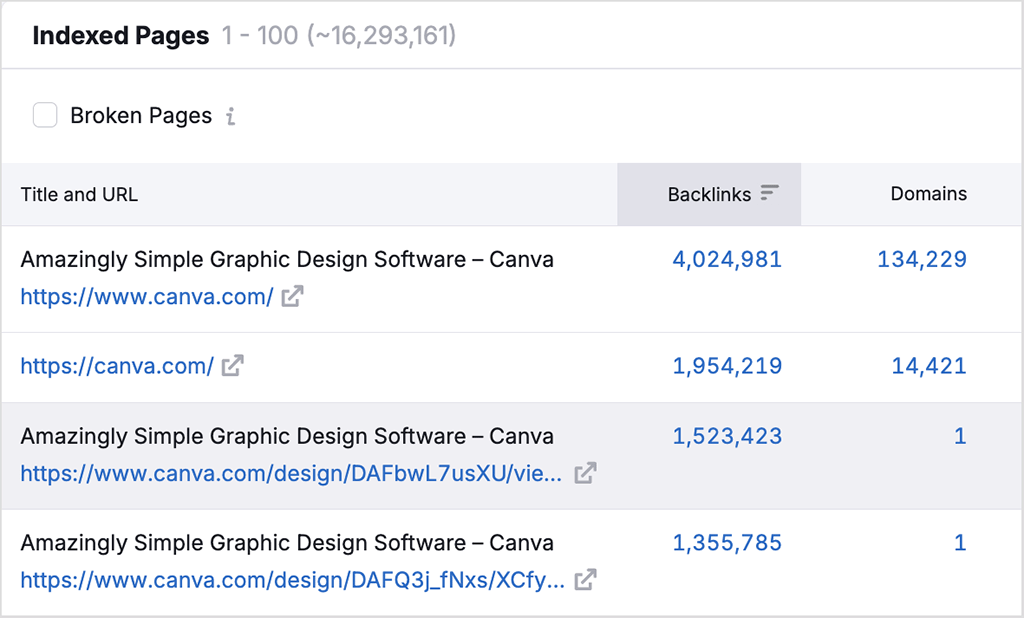
Majestic, by contrast, focuses exclusively on link structure, authority and trust flow. It’s excellent at revealing the shape of a site’s backlink graph, and its topical trust metrics provide useful signals about relevance. But it stops short of connecting these links to SEO outcomes like keyword visibility or traffic — and this makes it harder to evaluate their real-world impact.
In short, if you’re looking for a pure, structural view of backlinks, you’ll do well with Majestic. But for SEOs who want to understand how backlinks are actually influencing performance — and to take action based on that — Semrush is the better option.
7. Semrush gives you extensive PPC data
Majestic doesn’t provide any data relating to pay-per-click (PPC) advertising.
Semrush, by contrast, gives you a fully-fledged PPC toolkit that covers everything from competitor keyword targeting and ad copy to estimated budgets, ad positions and landing pages. This makes it a far more valuable platform for marketers working across both SEO and paid campaigns — especially those who want a complete picture of how competitors are driving traffic via both organic and paid channels.
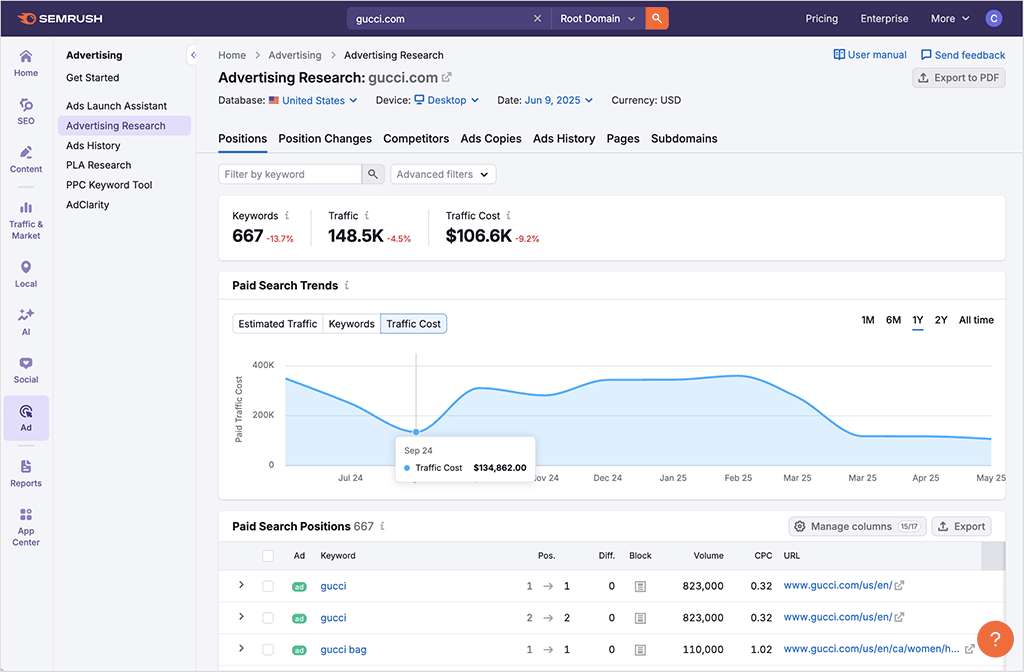
With over a billion Google ads in its archive, Semrush provides insights not just into what competitors are saying, but how they’re positioning themselves over time. This can be invaluable when planning your own PPC strategy, or running SEO–PPC crossover campaigns.
In short, for users juggling both organic and paid search, Semrush provides everything under one roof — while Majestic offers nothing in this area.
8. Semrush provides branded reporting and collaboration tools
Semrush is particularly strong when it comes to reporting and workflow support — two areas that matter a great deal for agencies, consultants and in-house teams.
The platform lets you create branded, fully customizable reports, automate scheduled exports, and include charts, competitor data, site audits and keyword tracking results in a neatly-presented document. You can also use it to set up white-labeled portals where clients can access live reports.
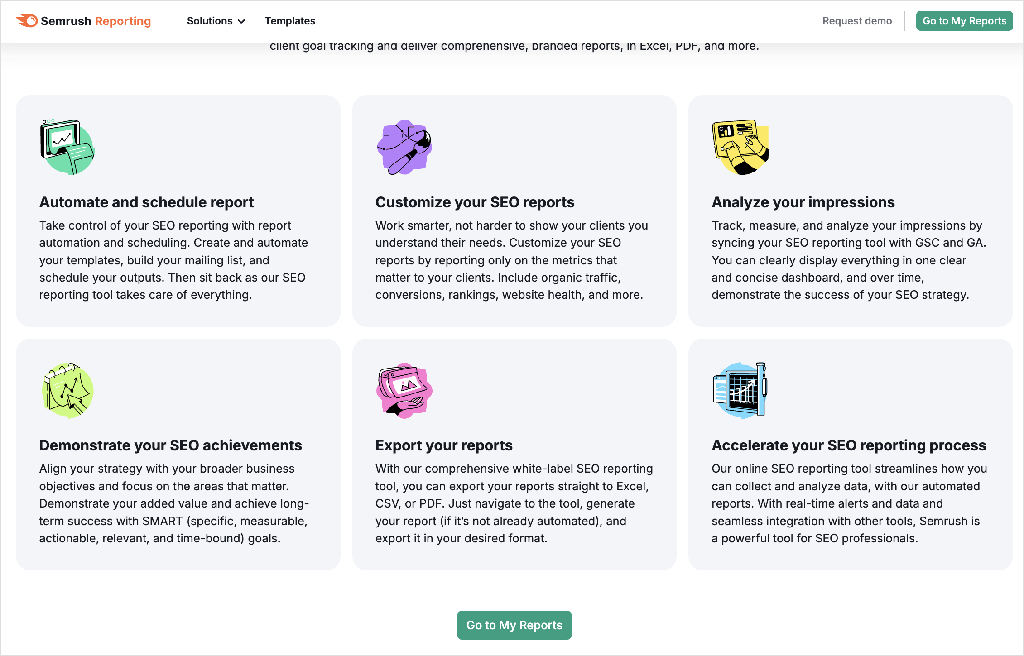
In addition to report generation, Semrush supports collaboration directly within the platform. You can assign tasks to users, add comments to data and track progress across SEO campaigns. Semrush also provides a native integration with Google Looker Studio, giving teams more flexibility in how they analyze and present their data.
Majestic doesn’t offer these types of collaborative or client-facing features. While it allows you to export backlink data into CSV or PDF files, it doesn’t give you any built-in functionality for assembling polished reports or coordinating SEO work across a team.
So, if you’re managing multiple projects or reporting to clients, the much more practical choice is Semrush.
9. Semrush gives you access to a generous free trial
Majestic doesn’t offer a fully-functional free trial. It lets you create a free account, but this is very limited in scope — key features like referring domain data, keyword tools and backlink comparisons are locked. This makes it very hard to test the platform out properly without investing in a subscription.
By contrast, Semrush gives you access to all its key data and tools as part of a fully-functional free trial. Normally speaking this lasts just seven days, but if you use the links below, you can access exclusive double-length Semrush trials.
Majestic SEO vs Semrush: the verdict
While Majestic brings some unique strengths to the table — particularly when it comes to historic link data, trust-based metrics, and visualizing link networks — the truth is it’s a difficult tool to recommend to most users in 2025.
The platform feels increasingly out of step with how modern SEO is practised. It lacks core features like keyword research, site auditing, and rank tracking, and even in its specialist area of backlink analysis, it now lags behind Semrush in several key respects (like link-building outreach, contextual link insights and the provision of traffic and ranking data).
That said, it may still hold value for more niche use cases — such as domain brokers or SEOs focused specifically on historical link trust metrics.
But of the two platforms under discussion, Semrush is the tool I’d reach for in almost any real-world SEO or digital marketing scenario.
It’s not just that Semrush offers more features — it delivers them in a far more user-friendly, visually engaging way. Its interface is slick, its workflows make sense, and it continues to evolve with smart touches like personalized keyword difficulty scores and intuitive content optimization tools.
While it’s not the cheapest option on the market, if you’re looking for an SEO tool that’s both extremely powerful and genuinely enjoyable to use, Semrush is the clear winner.
If you have any thoughts or questions on Majestic SEO vs Semrush, do feel free to leave them in the comments section below. We read them all and will do our best to help.
Don’t miss out on our free SEO toolkit
For a limited time only we’re offering our readers some excellent free SEO tools and resources. Sign up now to immediately receive:
- our downloadable cheatsheet containing the 20 key steps to ranking highly in search results
- extended free trials and discounts for leading SEO tools
- our downloadable cheatsheet on how to grow organic traffic to a blog
- 2 in-depth guides to SEO
- ongoing free tips and advice on SEO and growing your business
Alternatives to Majestic and Semrush
There are lots of alternatives to Majestic and Semrush available. Some of the key ones include:
- Ahrefs
- SE Ranking
- Moz
- SpyFu
- Ubersuggest
- Mangools
- Serpstat
- Similarweb
- Growthbar
- SEO PowerSuite
- Google Keyword Planner
To learn more about Ahrefs, you can explore our full Ahrefs review — and if you’re weighing it against Semrush, our in-depth Ahrefs vs Semrush comparison is worth a read too.
If you’re curious about Moz, be sure to check out our Moz review and our Moz vs Semrush and Moz vs Ahrefs comparisons — and for a broader perspective, we also have a detailed three-way comparison of Moz, Ahrefs, and Semrush available.
If you’d like to explore how SE Ranking stacks up against other tools, take a look at our SE Ranking vs Semrush and SE Ranking vs Moz comparisons — both provide a clear breakdown of features, pricing, and usability.
And finally, if you’d like to compare several of these platforms side by side, check out our ‘Best SEO tools’ article — this weighs up the pros and cons of ten leading SEO platforms.
No comments